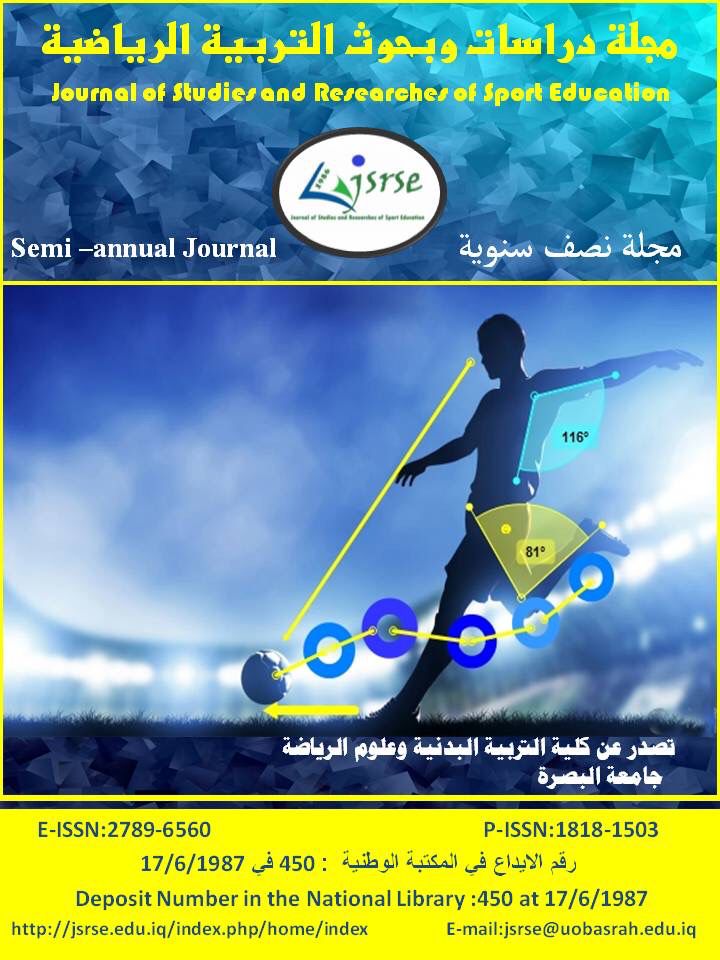Mood Patterns Among the Female Footballers in Palestine
Main Article Content
Abstract
This study aimed at identifying mood patterns among the female footballers in Palestine, in addition to determining the differences between mood patterns according to the variables of experience in playing and playing position. In order to achieve the study objectives, the study was applied to a sample that consisted of (57) female footballers, The researchers used the descriptive approach. The study applied the checklist of athlete's mood patterns which consisted of (30) items. The results showed that the level of mood patterns among the female footballers was medium, where the percentage of the responses was The results also revealed that the dimension of personal flexibility was in the first place with a relative weight, followed by the dimension of stimulation processes and the dimension of ceasing processes, The results revealed that there are no statistically significant in the distinctive mood patterns among the female footballers in Palestine attributed to the variable of experience in playing concerning the dimension of the intensity of stimulation processes, and there are no differences attributed to the variable of playing position. The researchers recommend the necessity of exposing the female footballers to various situations with psychological stressors in order to improve their adaptation ability in the various situations.
Article Details

This work is licensed under a Creative Commons Attribution-NonCommercial 4.0 International License.
References
AbdulRasoul, T. H., Aldewan, L. H., & Muslim, A. J. (2019). Effect of Daniel ’s model in teaching basic skills of football halls. Journal of Studies and Researches of Sport Education, 58, 11–25.
Ahmed, A. Y. A.-R. (2016). Temperamental Pattrens and their Relationship to the Distinctive Psychological Skills of Karate Players,. International Scientific Conference, Sport Is a Regular Part of a Lifestyle.
Ali, I. H., Aldewan, lamyaa hasan, & AbdelHussein, F. H. (2019). The effect of using the Closemire model according to the cognitive method (impulsive versus speculative)In learning some skills with gymnastic on a device Balance beam for female students. Journal of Studies and Researches of Sport Education , 59, 11–27.
Al-Ahmad, W., & Katabi, M. (2021). Temperamental personality and its relationship to attachment styles among Damascus University students. Al-Baath University Journal ,Educational Sciences Series.
Allawi, M. (1998). An Introduction to Sports Psychology (2nd ed.). Al-Kitab Publishing.
Allawi, M. (2004). Introduction to Sport Psychology (4th ed.). Al-Kitab Center for Publishing.
Al-Saadani, H., & Abdel-Hamid, G. (2001). Temperamental Characteristics and Vital Patterns of Swimming and Athletics Players. Journal of Sports Science, 13, 121–137.
Anbeid, A. A.-S., Suleiman, M., & Saeed, A. A.-S. (2020). constructing a list of mood patterns scale for handball juniors under 16 years old. Journal of Sport Sciences , 4.
Berry, T. (1997). The Role of Nod State in Assessing Rugby Plovers Perceptual and Motor Skills . 91, 112–132.
Guttman, A. (2007). The Diffusion of Sports and the Problem of Cultural Imperialism. In Eric Dunning, Joseph A. Maguire, Robert E Pearton. The Sport Process: A Comparative and Developmental Approach.
Jaber, R. (2013). Characteristic Mood Patterns of Table Tennis Players in Palestine . Journal of the University of Jordan for Educational Sciences Studies, 40(1).
Mansour, N., & Al-Issawy, A.-S. (2020). Sports Competition Anxiety and Mood Pattern and Their Relationship to Vitamin D25 Levels and Parathyroid Hormone for Soccer Players. Scientific Journal Education and Sport Sciences.
Ratib, O. (1997). Sports Psychology (Concepts-Applications) (2nd ed.). Dar Al-Fikr Al-Arabi.
Shaheen, S., & Ashraf, R. (2008). Emotional Intelligence and its Relation to the Mood Patterns of Sports Players," a predictive study". The Fourth Regional Conference of the International Council for Health, Physical Education, Recreation, Sports and Motor Expression for the Middle East.
Winges, H. (2012). Athlete Perceptions and Conseguences of Parental Background Anger in Youth Ice Hockey. University of Minnesota .
Yahya, H. (2006). Mood State and Level of Nervous Stress and their Relationship to Match results among Judo Players. Journal of Theories and Applications , 59, 67–81.





 IASJ
IASJ CC-BY-4.0
CC-BY-4.0 turnitin
turnitin ISSN
ISSN DOAJ
DOAJ Crossref
Crossref GoogleScholar
GoogleScholar Orcid
Orcid